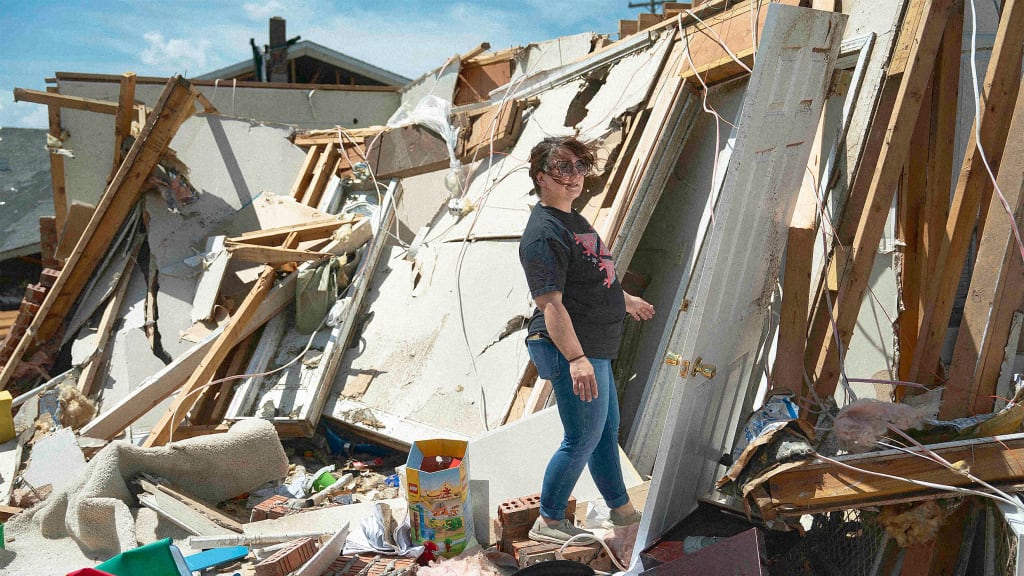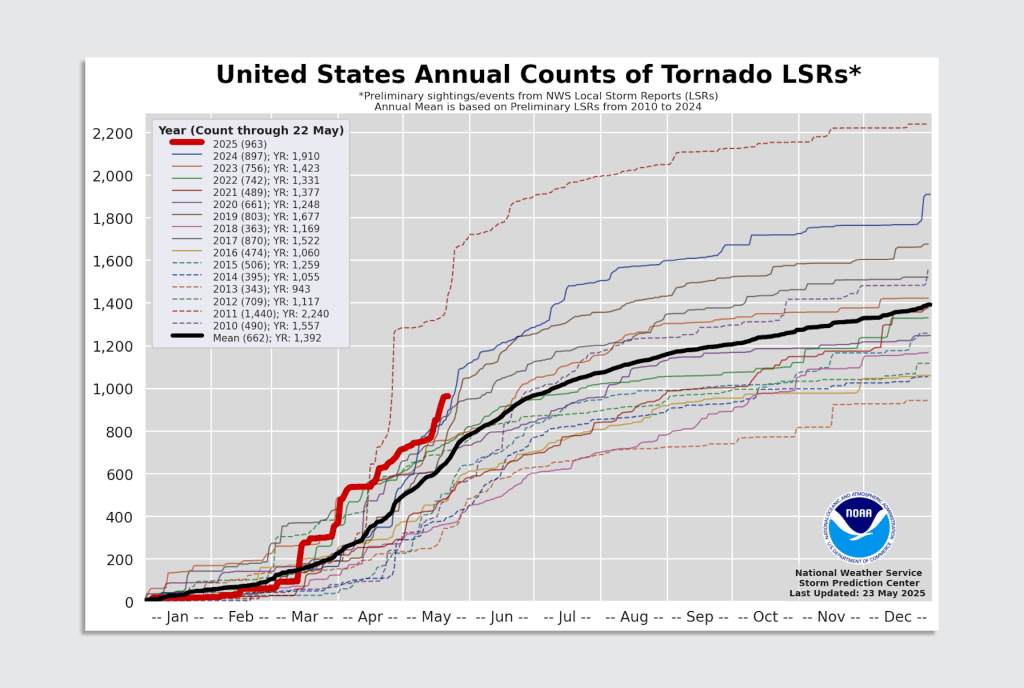Violent tornado outbreaks, just like the storms that tore by way of components of St. Louis and London, Kentucky, on Might 16, have made 2025 appear to be an particularly lively, lethal and destructive year for tornadoes.
The U.S. has had extra reported tornadoes than regular—greater than 960 as of May 22, in keeping with the Nationwide Climate Service’s preliminary rely.
That’s properly above the nationwide common of round 660 tornadoes reported by that time over the previous 15 years, and it’s much like 2024—the second-most-active year over that very same interval.
I’m an atmospheric scientist who research pure hazards. What stands out about 2025 up to now isn’t simply the variety of tornadoes, however how Twister Alley has encompassed nearly all the pieces east of the Rockies, and the way twister season is changing into all yr.
Why has 2025 been so lively?
The excessive twister rely in 2025 has loads to do with the climate in March, which broke data with 299 reported tornadoes—far exceeding the common of 80 for that month over the previous three a long time.

March’s numbers have been pushed by two massive twister outbreaks: About 115 tornadoes swept throughout more than a dozen states March 14 to 16, stretching from Arkansas to Pennsylvania; and 145 tornadoes hit March 31 to April 1, primarily in a swath from Arkansas to Iowa and eastward. The 2025 numbers are preliminary pending ultimate analyses.
Whereas meteorologists don’t know for positive why March was so lively, there have been a few substances that favor tornadoes:
- First, in March the climate was in a weak La Niña sample, which is related to a wavier and stormier jet stream and, usually, with more U.S. tornadoes.
- Second, the waters of the Gulf were much warmer than normal, which feeds moister air inland to gas extreme thunderstorms.
By April and Might, nevertheless, these substances had light. The weak La Niña ended and the Gulf waters have been closer to normal.
April and Might also produced twister outbreaks, however the preliminary rely over most of this era, for the reason that March 31 to April 1 outbreak, has really been close to the average, although issues may nonetheless change.
What has stood out in April and Might is persistence: The jet stream has remained wavy, bringing with it the traditional ebb and circulation of stormy low-pressure climate techniques combined with sunny high-pressure techniques. In May alone, tornadoes have been reported in Colorado, Minnesota, Delaware, Florida, and nearly each state in between.
Years with fewer tornadoes usually have calm durations of a few weeks or longer when a sunny high-pressure system is parked over the central U.S. Nevertheless, the U.S. didn’t actually get a kind of calm durations in spring 2025.
Twister Alley shifts eastward
The places of those storms have additionally been notable: The 2025 tornadoes by way of Might have been widespread however clustered close to the lower and central Mississippi Valley, stretching from Illinois to Mississippi.
That’s properly to the east of conventional Tornado Alley, usually seen as stretching from Texas by way of Nebraska, and farther east than normal. April by way of Might remains to be peak season for the Mississippi Valley, although it’s often on the japanese fringe of exercise quite than on the epicenter. The normal seasonal cycle of tornadoes strikes inland from close to the Gulf Coast in winter to the higher Midwest and Nice Plains by summer time.

Over the previous few a long time, the U.S. has seen a broad shift in tornadoes in 3 ways: to the east, earlier in the year, and clustered into larger outbreaks.
Winter tornadoes have turn into extra frequent over the japanese U.S., from the southeast, dubbed Dixie Alley for its twister exercise lately, to the Midwest, significantly Kentucky, Illinois, and Indiana.
In the meantime, there was a gradual and stark decline in tornadoes in the “traditional” tornado season and region: spring and summer time typically, particularly throughout the Nice Plains.
It might come as a shock that the U.S. has actually seen a decrease in overall U.S. tornado activity over the previous a number of a long time, particularly for intense tornadoes categorized as EF2 and above. There have been fewer days with a twister. Nevertheless, these twister days have been producing more tornadoes. These trends may have stabilized over the previous decade.
Deadlier tornadoes
This eastward shift is probably going making tornadoes deadlier.
Tornadoes within the Southeastern U.S. are more likely to strike overnight, when persons are asleep and can’t shortly defend themselves, which makes these events dramatically more dangerous. The twister that hit London, Kentucky, struck after 11 p.m. Most of the victims have been older than 65.
The shift towards extra winter tornadoes has additionally left individuals extra susceptible. Since they might not count on tornadoes at the moment of yr, they’re prone to be much less ready. Twister detection and forecasting is rapidly improving and has saved 1000’s of lives over the previous 50-plus years, however forecasts can save lives provided that persons are in a position to obtain them.
This shift in tornadoes to the east and earlier within the yr is similar to how scientists count on extreme thunderstorms to change as the world warms. Nevertheless, researchers don’t know whether or not the general downward pattern in tornadoes is pushed by warming or will proceed into the long run. Field campaigns learning how tornadoes type might assist us higher reply this query.
Do not forget that it solely takes one
For security, it’s time to cease specializing in spring as twister season and the Nice Plains as Twister Alley.
Twister Alley is de facto all of the U.S. east of the Rockies and west of the Appalachians for a lot of the yr. The farther south you reside, the longer your twister season lasts.
Forecasters say it yearly for hurricanes, and we badly want to begin saying it for tornadoes too: It only takes one to make it a nasty season for you or your neighborhood. Simply ask the residents of London, Kentucky; St. Louis; Plevna and Grinnell, Kansas; and McNairy County, Tennessee.
Take heed to your native meteorologists so you’ll know when your area is going through a twister threat. And if you hear sirens or are under a tornado warning, instantly go to your secure house. A twister might already be on the bottom, and you will have solely seconds to guard your self.
Daniel Chavas is an affiliate professor of atmospheric science at Purdue University.
This text is republished from The Conversation underneath a Artistic Commons license. Learn the original article.


